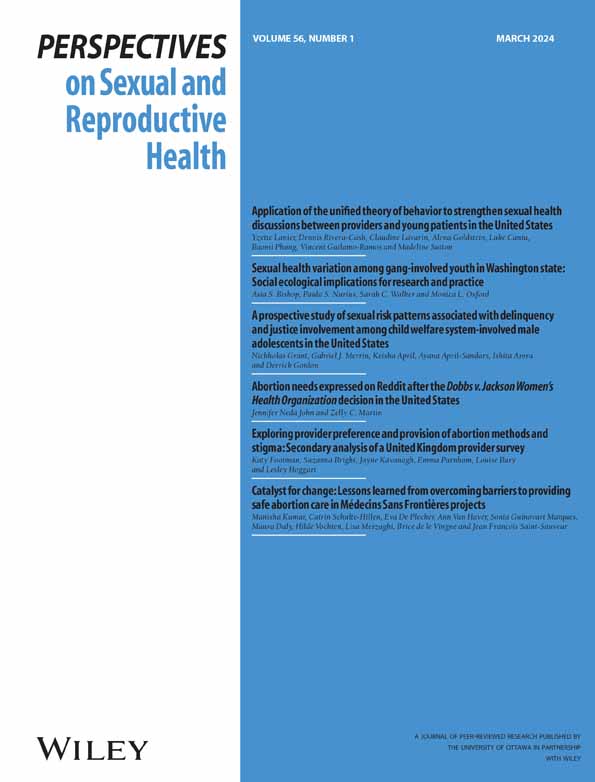了解俄亥俄州、西弗吉尼亚州和肯塔基州这三个限制堕胎州的堕胎合法性和三个月的堕胎护理情况
IF 3.5
2区 医学
Q1 DEMOGRAPHY
引用次数: 0
摘要
导言在多布斯时代,美国堕胎护理的合法性取决于各州的法律。即使在多布斯时代之前,当堕胎仍然合法时,围绕合法堕胎的越来越多的限制和争论可能会导致对堕胎合法性的混淆,并阻碍患者进行合法堕胎。我们假设认为堕胎是非法的或对合法性的不确定性与较晚的堕胎护理时间之间存在关联。方法我们在 2020 年 4 月至 2021 年 4 月期间对俄亥俄州、西弗吉尼亚州和肯塔基州寻求堕胎护理的患者进行了调查。我们询问了他们在首次决定堕胎时对堕胎合法性的理解。使用无条件逻辑回归模型,我们研究了堕胎合法性信念(以堕胎合法或有时合法与非法或不确定的信念衡量)与堕胎护理时间(以堕胎三个月衡量)之间的关联。结果在符合资格标准并完成调查的 1479 名患者中,超过一半(57%)认为堕胎始终合法,21% 认为堕胎有时合法,12% 认为堕胎非法,10% 不知道。大多数人(92%)在怀孕头三个月(妊娠 14 周)进行了人工流产。认为人工流产非法或不确定人工流产是否合法与第二孕期人工流产护理并无明显关联(未经调整的几率比 [uOR]:0.78,95% 置信区间 [CI]:0.50-1.20)。讨论在多布斯州之前,在三个限制人工流产的州中,每五名前来寻求人工流产护理的患者中就有一人以上错误地认为人工流产是非法的或不确定人工流产是非法的。对合法性的理解与人工流产护理的时间并无明显关联。在多布斯州,这些误解可能会加剧。本文章由计算机程序翻译,如有差异,请以英文原文为准。
Understanding abortion legality and trimester of abortion care in Ohio, West Virginia and Kentucky, three abortion‐restrictive states
IntroductionIn the era of Dobbs, legality of abortion care in the United States depends upon state law. Even before Dobbs, while abortion remained legal mounting restrictions and debate surrounding legal abortion could have led to confusion about abortion legality and discouraged patients from accessing legal abortion. We hypothesized an association between believing abortion is illegal or uncertainty about legality with later timing of abortion care.MethodsWe surveyed patients seeking abortion care in Ohio, West Virginia, and Kentucky from April 2020 to April 2021. We asked about their understanding of abortion legality at the time they were first deciding to have an abortion. Using unconditional logistic regression models, we examined associations between beliefs about abortion legality (measured as belief that abortion is legal or sometimes legal versus. illegal or unsure) and timing of abortion care (measured as trimester of abortion).ResultsOver half (57%) of the 1,479 patients who met eligibility criteria and completed the survey believed abortion was always legal, 21% thought abortion was sometimes legal, 12% believed abortion was illegal, and 10% did not know. Most (92%) had a first trimester abortion (<14 weeks gestation). Belief that abortion was illegal, or uncertainty about abortion legality, was not significantly associated with second trimester abortion care (unadjusted odds ratio [uOR]: 0.78, 95% confidence interval [CI]: 0.50–1.20). This association did not change meaningfully after adjusting for demographic and clinical variables (adjusted OR [aOR]: 0.83, 95% CI: 0.51–1.33).DiscussionMore than one in five patients presenting for abortion care in three abortion‐restrictive states prior to Dobbs erroneously believed that abortion was illegal or were unsure. Understanding of legality was not significantly associated with timing of abortion care. These misunderstandings could escalate under Dobbs.
求助全文
通过发布文献求助,成功后即可免费获取论文全文。
去求助
来源期刊
CiteScore
5.10
自引率
3.40%
发文量
24
期刊介绍:
Perspectives on Sexual and Reproductive Health provides the latest peer-reviewed, policy-relevant research and analysis on sexual and reproductive health and rights in the United States and other developed countries. For more than four decades, Perspectives has offered unique insights into how reproductive health issues relate to one another; how they are affected by policies and programs; and their implications for individuals and societies. Published four times a year, Perspectives on Sexual and Reproductive Health includes original research, special reports and commentaries on the latest developments in the field of sexual and reproductive health, as well as staff-written summaries of recent findings in the field.

 求助内容:
求助内容: 应助结果提醒方式:
应助结果提醒方式:


